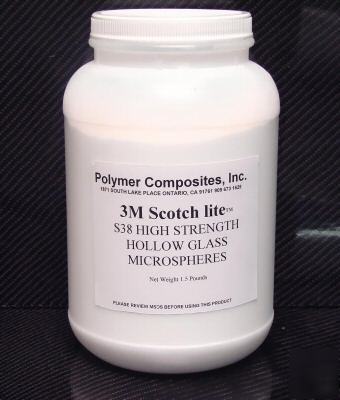____________________ > Albion
> System components
> Old Style
> Motor Components
> Diesel Motor Components
> Microspheres glass bubbles low density epoxy filler
Microspheres glass bubbles low density epoxy filler
3M Scotchlite S38-HS Direct PDF Page
http://209.85.173.132/search?q=cache:OXERPQuJfc8J:multimedia.3m.com/mws/mediawebserver%3F66666UuZjcFSLXTt5X%266m8z6EVuQEcuZgVs6EVs6E666666-+3M%E2%84%A2+Scotchlite%E2%84%A2+S38-HS&hl=en&ct=clnk&cd=13&gl=us
S38-HS 3M Scotchlite are engineered hollow glass microspheres that are inert fillers typically incorporated with an epoxy resin to lower its density and improve buoyancy, process sanding, dimensional stability and reduce shrinkage. This unique low density filler is used in a wide range of industries to reduce part weight, lower costs and enhance mechanical properties. The unique spherical shape of Scotchlite glass bubbles offers a number of important benefits including higher filler loading with minimal viscosity increase, reduce exothermic temperatures for large castings while minimizing shrinkage and warping of the casted part.
Add this low density filler to an epoxy resin system and create what is known as a "SYNTACTIC FOAM" in the composite materials industry. Syntactic foams are commonly used as light weight adhesives and casting materials that demonstrates improved chemical resistance. It can its typically used as a low density coating, a tooling compound or as a dimensional stable casting resin for composite parts fabricating.
Cured casted parts are typically buoyant in water also yields higher dimensional stability, improved machining and sanding and low porosity. The microspheres are hollow glass bubbles thus creating a very strong foam systems with closed cells. This will yield a low porosity integral skin that provides moisture resistance as well as low gas permeability over a wide service temperature.
MATERIALS THAT HAVE A SPECIFIC GRAVITY GREATER THAN WATER WILL SINK AND
MATERIALS THAT HAVE LOWER SPECIFIC GRAVITY WILL FLOAT.
DENSITY OF BASE UNFILLED EPOXY RESIN
1.10 GRAMS PER CUBIC CENTIMETER
DENSITY OF EPOXY 30% FILLED WITH MICROSPHERES
0.85 GRAMS PER CUBIC CENTIMETER
1.00 GRAMS PER CUBIC CENTIMETER
The addition of the microspheres improves the weight to strength ratio and other physical properties of the epoxy system such as:
IMPROVED DIMENSIONAL STABILITY
IMPROVED ELECTRICAL PROPERTIES
DENSITY OF THE EPOXY RESIN WITH 25% TO 30% MICROSPHERES = 0.85 g/cc
Note the buoyant sample, which contains 30% by volume of the microsphere filler added to
The intended application of the syntactic foam is dictated by the amount of the microspheres added to the resin system. Mix equal parts by volume of microspheres with an epoxy resin system and obtain a pourable, self leveling syntactic foam that offers reduced weight per unit volume, suitable for casting parts with improve dimensional stability or as a low density adhesive used in maximizing reduction of structural wieght with little effect of the adhesion quality.
Higher loading of the microsphere will yield a paste like consistency suitable as a fairing compound with excellent stability in its Coefficient of Thermal Expansion or CTE . Adding a small amount of precipitated fumed silica, also known as Cab-O-Sil or Wacker will create a none-sagging or thixotropic compound that can be applied on vertical or overhead surfaces without flowing. Thixotropic syntactic foams can also be s brush or trowel applied coating with improved chemical and abrasion resistance.
When mixed with an epoxy based potting or encapsulating resin used in an electronic applications, the addition of the microspheres dramatically improves dielectric constants, volume resistivity or electrical insulative values as well as its cured chemical resistant properties.
MIXING TECHNIQUE WITH EPOXY RESIN
THE RESULTING MIXTURE CURES TO A HARD INTEGRAL SKIN THAT ELIMINATES WATER ABSORPTION AND IMPROVE FOAM DURABILITYTHE CURED SURFACE IS ALSO MACHINEABLE AND DEMONSTRATES EXCELLENT SANDABILITY.
APPLY A SKIN COAT UNTO EPS STYROFOAM. ONCE THE SYNTACTIC FOAM HAS CURED, POLYESTER RESIN CAN BE USED WITHOUT MELTING THE POLYSTYRENE FOAM CLICK ON THE PICTURE TO PAUSE OR PLAY SLIDE SHOW
REPAIR AND RESURFACING OF AN OLD POLYESTER SURFBOARD
Hollow Aluminum Rudder Filled Reinforced With Low Density Syntactic FoamPictures compliments of Jeff Stander S.V. Beatrix
MAX BOND MEDIUM VISCOSITY EPOXY RESIN
MAX BOND THIXOTROPIC EPOXY RESIN WHICH IS ALREADY PRETHICKENED WITH FUMED SILICA
MICROBALLONS ARE ALSO USED TO IMPROVE DIMENSIONAL STABILITY AS WELL AS SANDABILITY
MAX GPE MEDIUM SET/MICROSPHERES (1:1 RATIO)
CLICK ON THE PICTURE TO PAUSE OR PLAY SLIDE SHOW An Addition of 2% of Cab-O-Sil was added to the formulation to create a none-sagging paste(left). The original formula remained pourable and self leveling (right).
An Addition of 2% of Cab-O-Sil was added to the formulation to create a none-sagging paste (left).
A similar none sagging or thixotropic consistency can be achieved by using our
MAX BOND THIXOTROPIC RESIN SYSTEM
The original formula remained pourable and self leveling (right).
This formulation yields similar properties as our MAX EMC formulation as shown n the following slide show as the none flowing paste .
By omitting the use of the Cab-O-Sil in the formulation and using a lower viscosity epoxy resin system such as the MAX GPE A/B, a self-leveling casting resin is produced.
We purchase and mix our raw materials in large volumes, so we can offer our products at lower prices. All kits are manufactured and packaged at the time of order so that we guarantee fresh materials. These are not extras, re-packs, surplus or old inventory please inquiry for multiple lot discount.
FOR MORE PICTURES OUR PHOTO SHARING SITE CAN BE VIEWED AT:

